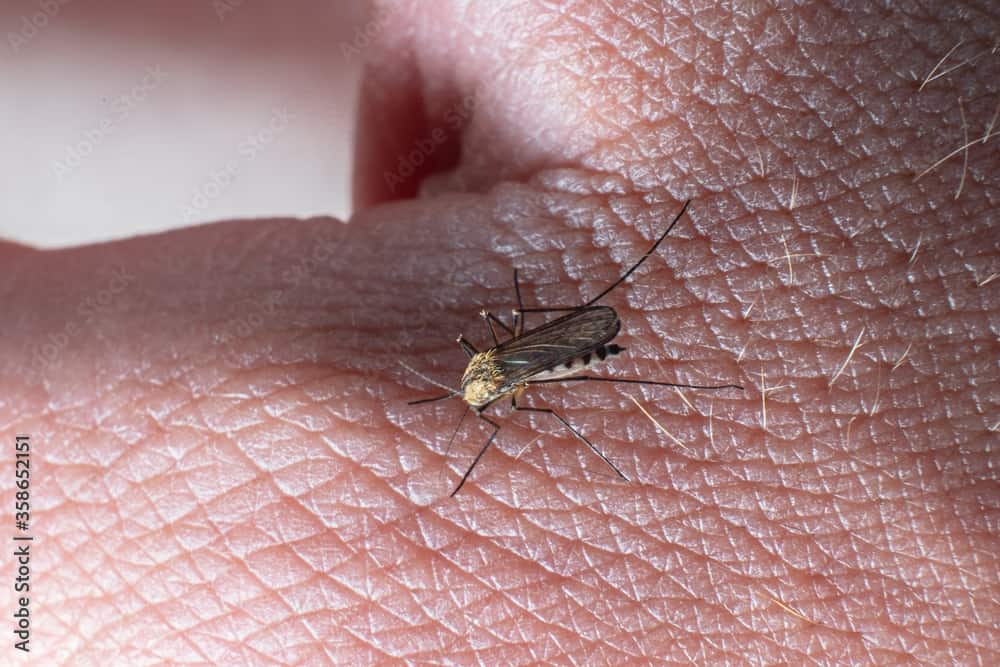Article, FEATURED STORIES, WORLD
Warmer Temps Prompt Increase in Insect-Borne Illnesses in the US

A mosquito bites a person with insect-borne infections
Concerns are rising in the U.S. as scientists caution warmer temperatures will likely lead to an increase in insect-borne illnesses.
Last Thursday, the Centers for Disease Control and Prevention (CDC) released data projecting a sharp increase in cases of the tick-borne disease alpha-gal syndrome. This disease, spread by the lone star tick, triggers a potentially severe reaction in those affected by multiple types of meat and other animal products.
The rate of people in the U.S. developing this rare meat allergy is rising, potentially affecting as many as 450,000 Americans. The tick that spreads this illness is generally found in the Southern and Eastern regions of the United States, but its scope is enlarging due to changing climates.
The alpha-gal syndrome is just one of many insect-borne diseases that have increased in the U.S. over the past decade.
US EXPERIENCES FIRST LOCALLY ACQUIRED MALARIA CASES IN 20 YEARS
This rise in tick-borne illness coincides with the first domestic-acquired malaria cases in the United States in 20 years.
The eight confirmed cases have affected individuals residing in Florida and Texas. Seven cases occurred in Sarasota County, Florida, while one occurred in Cameron County, Texas, where a man working for the National Guard stationed along the Rio Grande River developed symptoms.
Although the CDC is classifying the risk of locally acquired malaria as very low in the United States, experts warn that this could change with increasing temperatures.
In recent years, scientists have found mosquitos are migrating to new areas once considered inhospitable to these insects, exposing new populations worldwide to diseases.
RESEARCH LINKS CLIMATE CHANGE TO MOSQUITO EXPANSION
Pamela Martinez, a researcher who analyzed malaria trends in Ethiopia, commented on the link between temperature and the disease.
“We see that when temperature goes down, the overall trend of cases also goes down, even in the absence of intervention,” Martinez said. “That proves the case that temperature has an impact on transmission.”
Other experts seem to agree.
“The link between climate change and expansion or change in mosquito distributions is real,” said specialist Doug Norris, an expert in mosquitoes at the Johns Hopkins Bloomberg School of Public Health. Generally, mosquitoes grow faster in warmer conditions, he commented.
Furthermore, it’s not just warming temperatures that are lending mosquitoes an advantage. Lengthier wet seasons create more suitable environments for mosquitos, and droughts drive populations to store water in containers – leading to ideal breeding sites.
To combat such risks, the CDC recommends the public undertake measures to control mosquitoes at home and take steps to prevent mosquito bites. These include the removal of standing water, using mosquito larvicide in water that can’t be drained, and wearing long sleeves and EPA-registered insect repellents in high-risk areas.
VECTOR-BORNE DISEASE LINKED TO CLIMATE CHANGE
Diseases such as malaria and alpha-gal syndrome are sometimes referred to as vector-borne diseases. According to the World Health Organization, vectors are living organisms capable of transmitting infectious pathogens between humans or from animals to humans. Vectors include bloodsucking parasites which ingest illness-generating microorganisms from one host, spreading them to a new host when they feed again.
Some common vectors are mosquitos, ticks, and fleas.
The CDC’s National Center for Emerging and Zoonotic Infectious Diseases (NCEZID) has stated the risk for infectious diseases is increasing because of climate change, linking these risks to expanding vector populations.
“Milder winters, warmer summers, and fewer days of frost make it easier for these and other infectious diseases to expand into new geographic areas and infect more people,” the scientists from NCEZID warn.
These milder winters, earlier springs, and warmer temperature result in mosquitoes and ticks gaining a longer period in which they can reproduce, expand habitats, and spread disease. Between 2004 and 2018, the number of illnesses caused by mosquito, tick, and flea bites more than doubled. 760,000 cases were reported in the U.S. alone. During this period, nine new germs spread by ticks and mosquitoes were either introduced or discovered in the U.S.
Experts caution that cases of tick-borne diseases such as Lyme disease, spotted fever, rickettsiosis, and others could worsen as the geography of these parasites expands.
THREATS NOT LIMITED TO INSECT-SPREAD INFECTIONS
The NCEZID also warns of increased illnesses due to amplified contact with animals caused by habitat loss, forcing animal migrations into more human-habited populations.
Additional threats spawned by these increasing temperatures include disease-causing fungi and harmful algal blooms. Rising temperatures have permitted illness-provoking fungi to expand to areas once too cold for them to subsist, spreading diseases such as Valley fever to new locales. Rapid algae growth in lakes, rivers, bays, and oceans can be toxic, causing harm to wildlife, livestock, and pets, eventually altering the environment.
Scientists expect conditions to intensify along with changing climates, not just in the U.S. – but worldwide. The threat expands beyond vector-borne diseases, with research leading many to believe all pathogens known to cause disease to worsen as a result of climate change.
It will ultimately be up to governments, medical providers, organizations, and individuals’ actions to mitigate the effects of changing climates on populations as these threats continue to expand.

